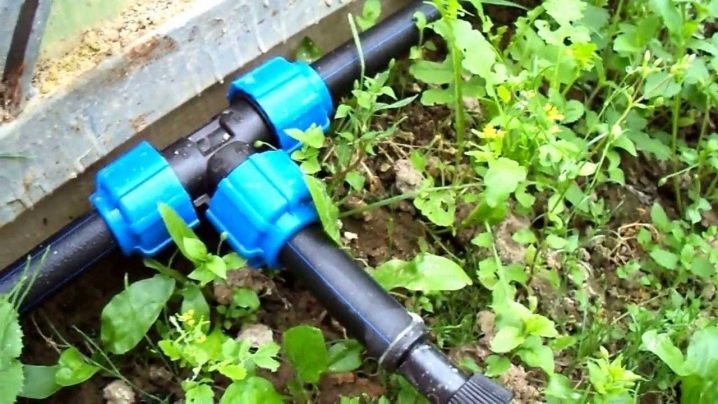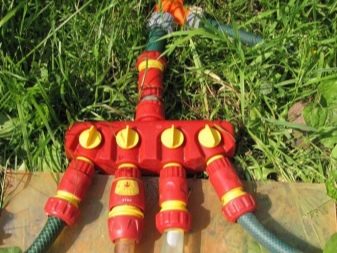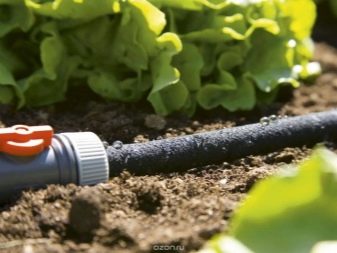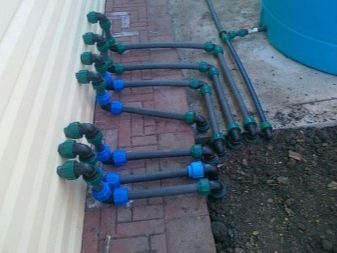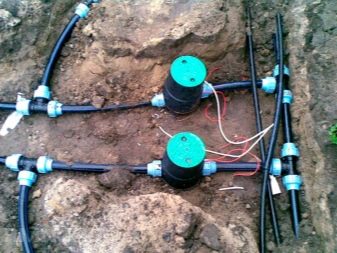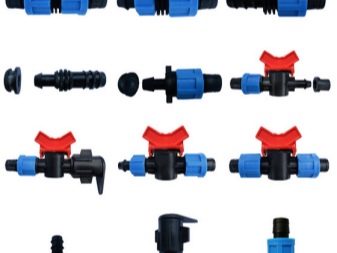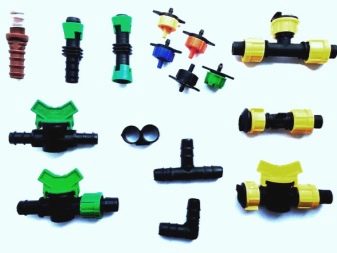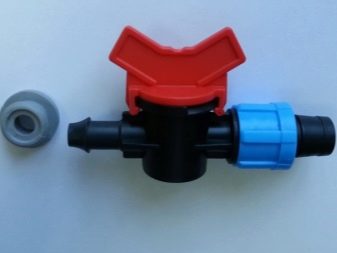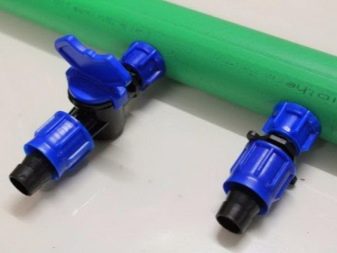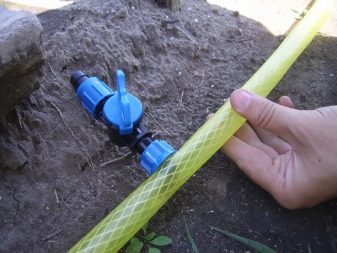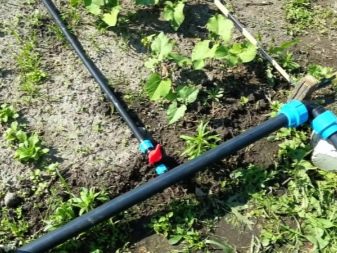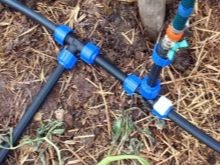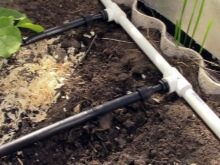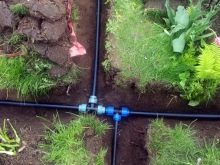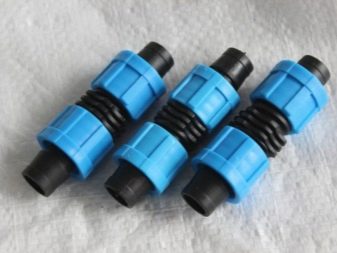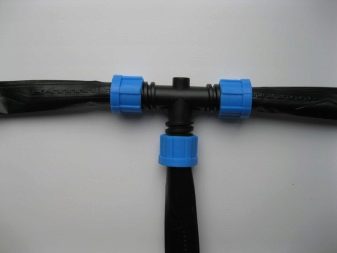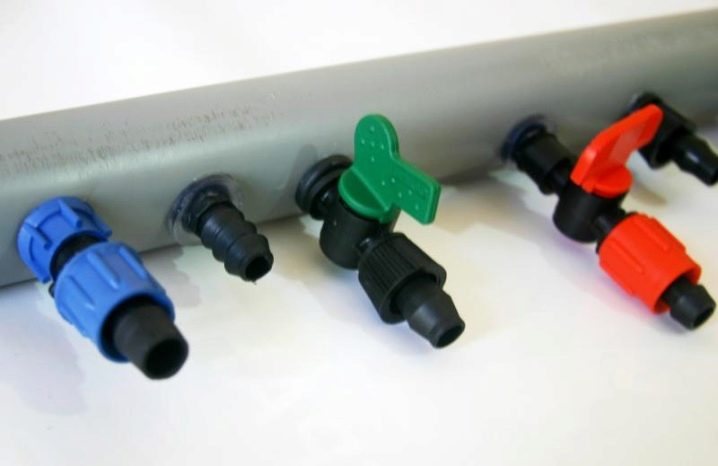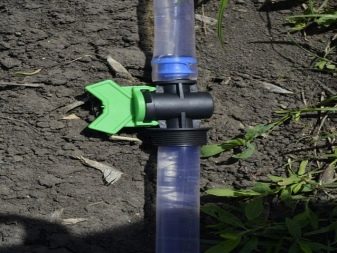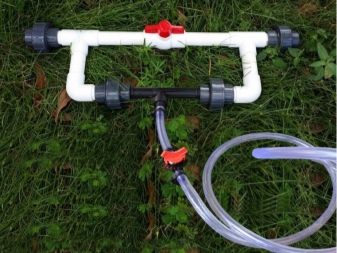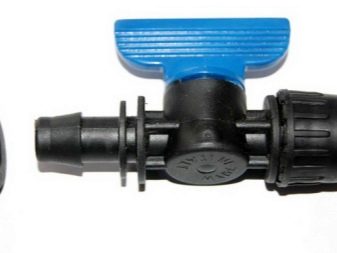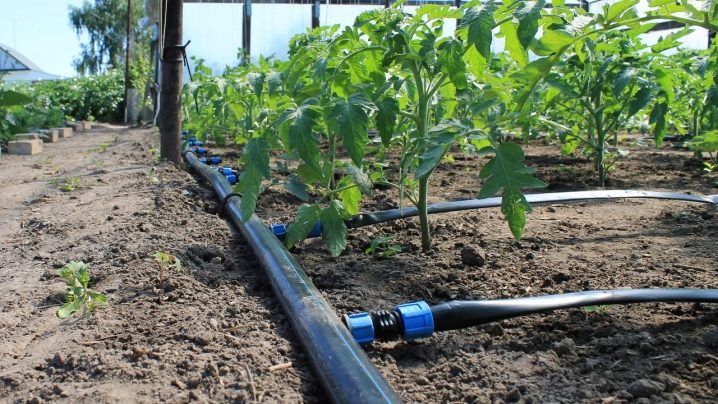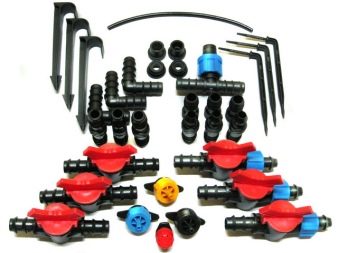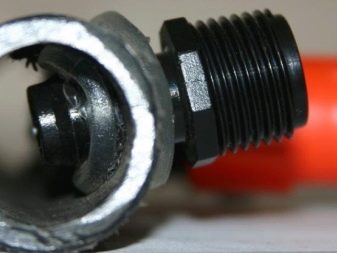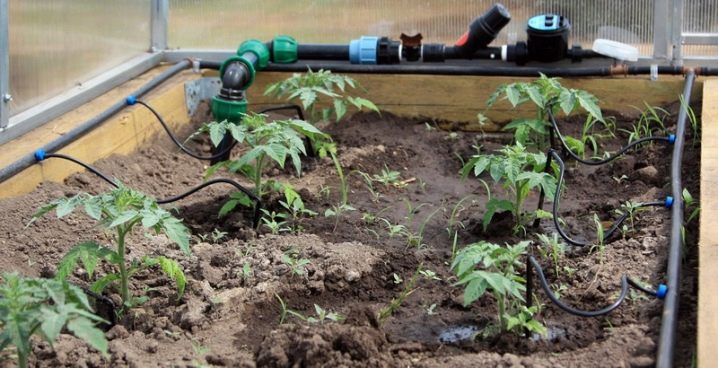Choosing fittings for drip irrigation

Drip system for irrigation of green space is widely used throughout the world. Dosed irrigation contributes to a significant reduction in water consumption, allows you to feed crops with nutrient mixtures, and also creates a microclimate favorable for plant growth and development. Arrangement of drip irrigation systems is possible due to a wide range of fittings, the proper operation of irrigation systems largely depends on the correct selection of them.
Manufacturing features
Fittings are shaped parts of the pipeline and are used for connecting, branching and dispensing water flows in the drip irrigation system.For the manufacture of parts, high-pressure polyethylene is used, which, thanks to the casting method, takes the necessary forms, and automatic machines are used as equipment. Parts can be produced from both primary and secondary raw materials. Primary polyethylene is produced at chemical plants based on the polymerization process of hydrocarbons, using a rigid system for controlling the quality of the produced raw materials. Such products are characterized by high physical strength and good resistance to ultraviolet radiation, and also meets the strict requirements of GOST.
Secondary raw materials are obtained as a result of primary processing, while producing cheaper but less quality products. So, fittings made from recycled plastic are characterized by low performance and fail faster. Such products worse endure permanent exposure to the sun, prone to cracking and deformation. The use of fittings from recycled materials is allowed during the formation of drip irrigation systems in summer cottages and in private houses.For installation on irrigation systems of large agricultural enterprises such products are not suitable. To reduce the cost of their products and improve the quality of shaped elements, some manufacturers mix primary and secondary polyethylenes, while obtaining products of fairly good quality and affordable cost.
Species
Fittings for drip irrigation are an important link between irrigation systems and are represented by several types that differ from each other not only constructively but also functionally. The elements differ by the type of feed line on which they will be installed. So, for rigid pipes fittings of the same type are used, and for installation on the drip tape - completely different. According to their functional purpose, the products are divided into three large groups.
- Simple assembly models used as connecting elements in the formation of branched irrigation systems and are represented by fittings, tees, threaded starters and brushes. Starters, in turn, are also represented by several types. The smallest representative is a mini-starter, featuring a small connection diameter (6 mm) and not requiring the installation of additional seals.A more versatile type is a starter equipped with a thread that connects the drip tape to the terminals located on the central piping.
To connect the irrigation system to thick-walled polypropylene or polyethylene pipes, a starter is widely used, equipped with a rubber sealing gasket. With this fitting, you can create quite tight connections even on openings with uneven walls. The sealing gasket in such models is reliably pressed by means of a clamping nut. In addition to the classic models, there are two or four outlet starters for the connection of droppers, and to make the streams of water of a certain direction use drip spokes.
Quick-release end caps do not have such a wide classification as starters, and are presented in the form of a round fitting, which muffles the end of the drip tape and eliminates the risk of leakage. Tee clamping action is designed to simultaneously attach the three tapes in one system and the formation of branches-sleeves, depending on the location of the beds.The clamping square is installed on the areas of strong bending of the drip tapes and ensures uniform drip irrigation throughout the system. The adapter is used to form a single node consisting of drip tapes and rigid pipes. In this case, the tape is connected to the unit with a clamping nut, and the tube is put on the brush.
Repair connection is used as a repair kit for tears and damage to drip tapes. The tee for tapes is installed on flexible watering hoses in those places where its connection is required. For this, a hose is cut, a tee is installed and a tape is connected. When forming a stationary irrigation system from PVC pipes instead of irrigation tapes, adjustable and compensated droppers are installed. The first ones allow adjusting the droplet size, and the second ones are applied on the sections having a large slope angle and with an unstable pressure level in the water pipes.
- Valves are a more complex type of fitting. and are used to increase the functionality of drip irrigation. Products are presented starting and passing models.Start, in turn, are divided into cranes with a clip, rubber seals and two types of connecting threads. Models with internal and external threads are designed for tapping the irrigation system into the central water supply system and attaching the drip tape.
Products with clips and gaskets provide a fairly tight connection between irrigation pipes and water supply in difficult and curved sections of the pipeline. Start connectors (starting cranes) equipped with gland nuts are allowed to be used for rigid HDPE with a diameter of 32 mm and for flexible hoses and nozzles with a diameter of 16 mm or more. Cranes with a sealant are used only for HDPE with a cross section exceeding 25 mm. All fittings are fully compatible with the pipeline and are available in different sizes, of which 3/4 and 1/2 are considered the most popular.
To connect flexible hoses, special starting cranes are used, which may have an internal thread, and through-valves, in which the hoses are pulled on a brush from both sides. In addition, there are pass-through models for drip tape, which is fixed with clamps on both sides.This provides a temporary disconnection from a watering of a certain patch of a bed, which is sometimes extremely necessary when two or more different crops grow in one patch.
- Fertilizer Fittings, allow you to deliver the necessary mineral supplements plants directly in the process of watering. Such devices include Venturi injectors, which use the difference in cross sections and thereby increase the speed of water movement, so that solutions of mineral fertilizers are drawn into the irrigation system and transferred to the plants. For the normal operation of the injector, a special hose is required, which is connected at one end to the injector, and the other to the tank with fertilizers. The microcrane is responsible for regulating the supply of the nutrient solution, and the air valve is used for bleeding off excess air. In addition, the valve is responsible for the continuous movement of the solution under the influence of weak pressure.
Criterias of choice
Before you start buying fittings for drip irrigation, you should make a detailed scheme with the designation of water intake sites and indicating the exact distance from it to each of the beds.If the irrigation is organized in the garden plots, then it is necessary to point out trees of different types that require an individual calculation of the irrigation intensity. The sequence of the connection of drip tapes and the operating time of the system, which can be separate or common for all plants, depends on the growth on one bed of different crops. Fittings must be purchased taking into account all the nuances of connection and only from reliable suppliers.
When buying, you should pay special attention to the smoothness of the surface of the products and the absence of burrs. The presence of cavities and defects in threaded connections is not allowed. If even slight deformations are found, the purchase of such a product should be abandoned. Most likely, such a model was made of recycled polyethylene, which is why, after being removed from the mold, it could shrink and bend more. Such fittings after installation do not guarantee a tight connection and often start to flow. In addition to the body of the fitting, you should inspect the ends of the clamps. They must be located strictly perpendicular to the central axis, even their minor deviations are not allowed.
Operation Tips
Due to the release of a large number of sizes and full compatibility with other elements of the pipeline, the installation of drop fittings is quite simple. Almost all products are equipped with an external or internal threaded connection, through which the necessary elements are wound onto pipes, tapes and hoses. Thanks to the plastic case, the service life of the fittings is long enough.
Despite their durability, it is recommended to observe some rules of operation.
- After drilling the holes for mounting the start fittings, thoroughly flush the system. To do this, after the installation of all parts, open the water and drive it under maximum pressure. After the system is flushed, you can proceed to the installation of the plug.
- It is necessary to buy a fitting with a small stock. The production of low-cost fittings "relaxes" the manufacturer, which often affects the quality of parts. Therefore, one or two copies should always be in stock. In addition, during the construction of the irrigation system, unanticipated changes in the route of the pipeline may occur,in view of which there will be a need for additional connecting elements or cranes.
- Do not allow sand to enter the system. This can cause clogging of the droppers and speed up the failure of the starting cranes.
Fittings for drip irrigation are important elements of all irrigation systems. Correct and durable operation of irrigation systems and the creation of favorable conditions for plant growth depend on their proper selection, installation and compliance with the rules of operation.
How to connect the fittings for drip irrigation do it yourself, see the following video.
